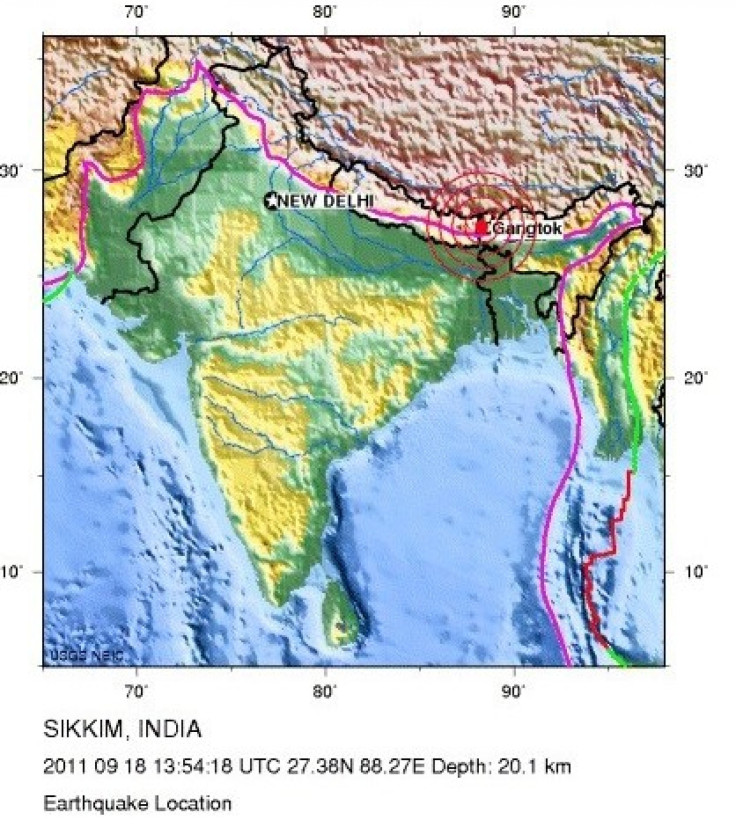6.8 Earthquake Rattles India; At Least 8 Dead

A magnitude 6.8 earthquake shook India's Sikkim state on Sunday night, sending people running from their homes. The epicenter of the quake was about 40 miles from Gangtok, the state's capital, on the Nepalese border.
The Indian government has reported that eight people died in India and Nepal, and at least three people died when a building in Kathmandu collapsed. The quake also created a number of mudslides on the outskirts of Gangtok, killing at least one man who was trapped inside his car.
Additionally, at least 100 people were injured, according to initial reports. The earthquake also temporarily disrupted telephone lines, and the rapid rate of cell phone use in the earthquake's aftermath overburdened mobile networks, according to The Hindustan Times.
The tremors were felt as far away as Delhi, about 900 miles to the west.
India sits on the Indian Plate, a tectonic plate that has been colliding with the Eurasia Plate for about 50 million years. The Indian Plate is slowly being wedged under Eurasia, pushing up the northern plate, causing it to lift. The tectonic movement created the Himalayan Mountain range, which straddles the collision point among India, Nepal, Tibet and China.
Because of the plates' movement, the Himalayas are growing taller every year.
Earthquakes in India aren't rare, but a 6.8 magnitude quake is significant. The most recent quake in the country occurred on Sept. 7, when a 4.2 magnitude quake hit Delhi, where just hours earlier a bomb blast killed 11 and injured dozens more outside the Delhi High Court.
Delhi is considered to be in Zone 4 of the Earthquake Hazard Map of India, and it is therefore designated as being in the High Damage Risk Zone. There hasn't been a significant earthquake in the city's recent history, although it has experienced minor vibrations from quakes elsewhere in the country and in Pakistan.
Gangtok is also in Zone 4, and it is nestled between two Zone 5 (highest risk) areas to the east and west.
On Sunday, there were also earthquakes reported in Virginia and New Zealand, although they were significantly less potent than the Sikkim quake.
A series of tremors in Virginia, ranging from magnitudes 1.9 to 2.1 on the Richter scale, are now considered to be aftershocks of the Aug. 23 earthquake that shook the East Coast of the United States, according to the U.S. Geological Survey. Meanwhile, a 4.1 magnitude quake hit North Queensland, New Zealand, around 2:30 a.m. Sunday.
There have not been any reports of injuries or damages in either location.
Last Thursday, two significant earthquakes happened in Cuba and Japan, ranging from magnitudes of 6.0 to 6.2, respectively.
Are multiple earthquakes in the same day anything to worry about?
Considering that there are about 1.5 million earthquakes a year, not really. And that's just above magnitude 2.0. Below that, there are millions more .
Additionally, USGS claims that 134 earthquakes between the magnitudes of 6 and 6.9 occur annually, the same magnitude as those that hit India, Cuba and Japan. Statistically, is it not unlikely that two would happened on the same day.
In the past week, there have been more than 250 earthquakes in Alaska alone, nearly 30 of which happened Sunday. In California and Nevada, there were nearly 400 quakes over the same period, the largest reaching around a 4.0 magnitude, according to USGS.
Yet, 2011 has seen its share of large-scale quakes. In March, a 9.0 earthquake hit Japan, causing enormous damage and a nuclear disaster at the Fukushima power plant. A month earthlier, a 6.3 magnitude earthquake in Christchurch, New Zealand, killed nearly 200.
On Sept. 6, a 6.6 magnitude earthquake hit the Indonesian island of Sumatra, killing a 12-year-old boy who was lying in bed and a man who died of a heart attack as he fled his home.
© Copyright IBTimes 2024. All rights reserved.











